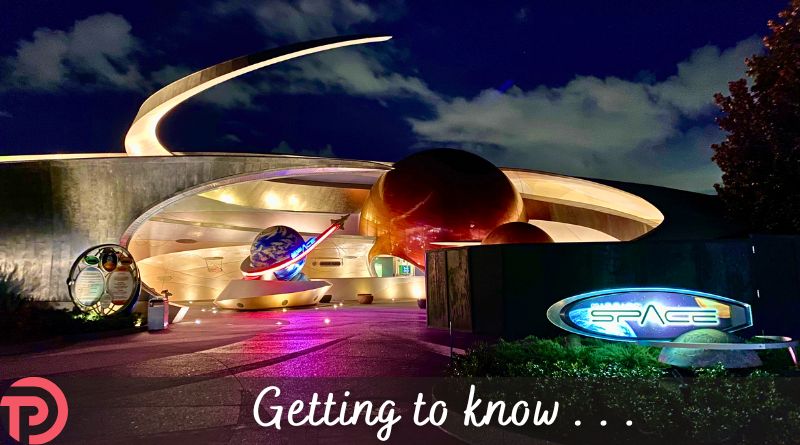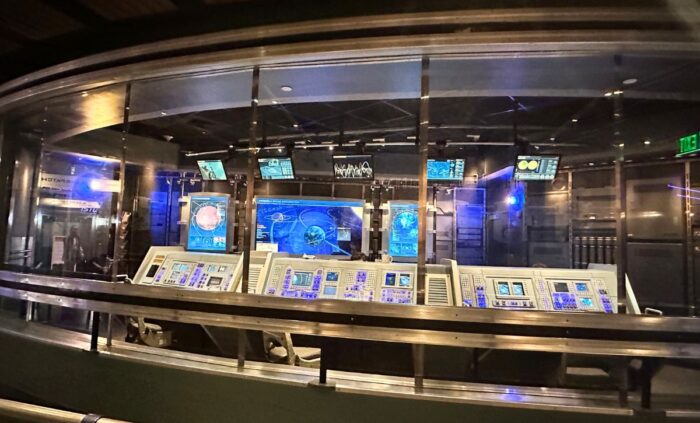
Five Things to Know About Mission Space
Mission: SPACE is a motion simulator offering two different ride experiences. The Orange Mission takes you on a wild-ride journey to Mars; the gentler Green Mission puts you in orbit around Earth. Which mission should you choose? Read on to help with your decision! Or if you prefer to blast off straight to the wheres, whys, and hows, here’s your shortcut (or wormhole, if you prefer).
1. You’ll prepare to launch before you get to the ride.
The blast-off excitement for Mission: SPACE begins even before you enter the building. When the sidewalk was redone a while back, NASA’s Jet Propulsion Laboratory provided Disney with pictures taken by the Mars rover Perseverance. They shared a 3D print file so Imagineers could recreate the tubes used to gather samples on Mars, and even loaned a prototype wheel of the Perseverance rover to create tread marks identical to those made by the rover as it explored Mars.

There’s a giant globe of earth with a rocket soaring around it, and giant models of Mars and Jupiter. As a Boomer, it reminds me of an episode of the Jetsons, when the future was full of possibilities and excitement!
When you enter the building, the queue is designed to look like a space training center: there are props from the 2000 film Mission to Mars, spacecraft models, and a replica of a NASA moon rover. Next, you enter the International Space Training Centers (ISTC), where you’ll see an introductory video from the ISTC’s Capsule Communicator (Capcom) played by actress Gina Torres. (Gary Sinise, who starred in the movie Mission to Mars, was the Capcom until 2017.) And then you’ll be off!
2. The Green ride is “gentler,” the Orange ride is more intense.
If you choose to ride Mission: SPACE, the Green ride is the better choice for anyone prone to motion sickness. It’s also the choice if you’re not sure which mission to choose! There’s no spinning on this version, and the movement is less turbulent. You won’t experience strong g-forces or weightlessness. But it’s no slow-moving dark ride; there’s still enough action that, for instance, expectant mothers are advised not to ride.
On either mission, as you board, you’ll be assigned one of four positions on your flight aboard the X-2 Deep Space Shuttle: navigator, pilot, commander, or engineer. You’ll be given two tasks to perform. (Don’t worry, nothing you do – or don’t do – will actually affect or harm the outcome of the journey.)
On the Green Mission, you’ll watch through the viewscreen as you experience liftoff and then enjoy a beautiful orbit around the Earth. During re-entry, you’ll have to manually navigate through a thunderstorm over the landing runway following the instructions from Capcom.
If you choose the Orange Mission, you’ll take off for Mars. This time, you’ll liftoff and your slingshot around the moon for a gravity assist before being placed into “hypersleep” for a couple of seconds before landing on Mars. As you might expect, when you awaken, “things go wrong” and Capcom must guide you through a series of actions intended to get you safely through a meteor belt and navigate a safe landing on the red planet.
Once you disembark either ride, you’ll go through the Advanced Training Lab interactive play area and the Mission Space: Cargo Bay gift shop. The ATL is a great place for littles or ride chickens (like me) to pass the time while others leave the planet. There are four interactive space areas to enjoy. Space Base is a playground area where kids can climb, go through “wormholes,” and use up some energy.
3. The history of SPACE.
When Disney was planning to develop EPCOT, Imagineers discussed including some type of pavilion devoted to space. A number of concepts were kicked around, one involving Ray Bradbury, but none came to fruition for a number of reasons. It was sometime around 1994 that the decision was made to create a space pavilion that would replace Horizons (a dark ride exploring what the future may look like). Horizons closed in 1999, and construction of Mission: SPACE began soon after. Experts estimated the cost at $100 million (nearly $200 million in today’s dollars). The new attraction was sponsored by Compaq, which worked with Imagineers on the design.
Completed in 2003, Mission: SPACE debuted in a soft opening in June. The grand opening was held on October 9, 2003, attended by then-Disney CEO Michael Eisner, Hewlett-Packard CEO Carl Fiorina, and NASA Administrator Sean O’Keefe. Several NASA astronauts from the Mercury, Gemini, Apollo, and Space Shuttle Programs, and two crew members from aboard the International Space Station also attended. It was a big deal!
From 2003-2006, Mission: SPACE was only the Orange mission, as we call it today. The less intense Green mission was added in 2006 because too many guests got motion sick on the ride! At the 2017 D23 Expo, it was announced that the Green Mission would get a new video about orbiting Earth; Orange would get new graphics and remain focused on a Mars mission.
When Compaq merged with Hewlett-Packard in 2002, HP took over sponsorship. In 2015, HP withdrew sponsorship, and its branding was removed.
4. There are Easter Eggs and Hidden Mickeys in Space.
⭐ Mission: SPACE contains several homages to Horizons. The Horizons logo is shown at the center of the gravity wheel in the queue. It’s also in some of the pre-show screens.
⭐ More than 650 Imagineers worked on Mission: SPACE, putting in 350,000+ man-hours (roughly equivalent to 40 years of full-time work!) during the planning and building stages.
⭐ In the Planetary Plaza outside the attraction, there’s a model of the moon. It’s dotted with gold markers showing landing sites for the 1959-1976 U.S. and Soviet missions to the moon

⭐ “Mission: SPACE” has a hidden Mickey in the stars/nebula mural in the cargo bay. Look for a classic Mickey head shape formed by stars in the painted nebula overhead. There are more to be found…keep your eyes peeled!
⭐ As you pass through the gift shop with all its space-themed items (but no Star Wars stuff here), check out the freeze-dried astronaut ice cream. The packaging reminds you that freeze-drying removes water from items, so your saliva actually re-hydrates the ice cream as you eat it. Tastes kind of like the real thing, but it just won’t be cold!
5. The Nuts and Bolts.
Mission: SPACE is located in the World Discovery section of EPCOT, between Cosmic Rewind and Test Track. Since it’s indoors, the weather doesn’t affect it. The ride itself is about 4-5 minutes, but from start to finish, including the pre-show, you should expect to take about 15 minutes. The queues for the different “sides” of the ride may be different in length, so be prepared to say which mission you’ll choose as you enter the building.
Each ride vehicle seats four people in individual padded chairs with armrests and an over-the-head padded shoulder restraint. Before the ride begins, the ride vehicle closes around guests and moves them closer to their screens, and the lights dim; some guests have found this claustrophobic. The seating and restraints may prohibit guests of certain body shapes or sizes from riding.
There’s a small step up to board the ride vehicle. Guests must transfer from a wheelchair/ECV to ride. Children will find they must be 40″ to ride the Green Mission and 44″ to ride the Orange Mission. Like all rides with a height requirement, Mission: SPACE offers Rider Switch. Service animals are not permitted on this attraction. Video captioning is available.
The warnings for the Orange Mission bear repeating here: Guests should not ride if they are uncomfortable with dark, close spaces or even slightly prone to motion sickness, as this attraction is a spinning simulator that creates g-forces. Some guests experience nausea, headaches, dizziness, disorientation, and even motion sickness, even if they have never experienced it before. Motion sickness bags are available inside the vehicle.
Mission: SPACE is open for Early Theme Park Entry and Extended Evening Theme Park Hours. It’s popular enough that when crowds are high, your best bet for a short wait is early in the morning or late at night. You can also use the Lightning Lane with a Multi- or Premier Pass.
The Bottom Line.
If you have the constitution and determination to ride, we rate this attraction as not to be missed. The level of theming, the attention to detail, and the actual ride itself make Mission: SPACE a truly unique and immersive experience. Motion sickness bags and all.
Have you been on Mission Space? What did you think? Let us know in the comments.









Good stuff per usual, Bob. As a claustrophobe, this is the one and only ride in all of WDW that I refuse to do. I did Orange once. I was aware of the claustrophobia warnings going in, but I was willing to give it a try. I found it too cramped in there with no easy way to move or get out in case of a oncoming panic attack. And for 4-5 minutes. It didn’t help that there was a delay in our take off. One and done.